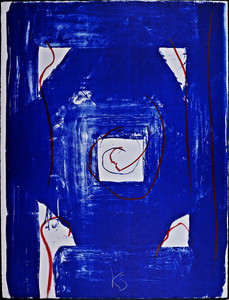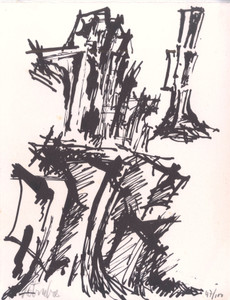
Jack Youngerman
Untitled Study #26, 1967
Gouache painting on paper (with original JL Hudson and PACE Gallery labels)
Hand signed and dated '67 on the front; J.L. Hudson
Gallery Label on Verso.
Unique
Frame included
This 1967 unique, signed gouache painting by renowned abstract expressionist painter Jack Youngerman was acquired from the estate of Anne Markley Spivak. It is held in the original vintage metal frame with the original J.L. Hudson Gallery label, as well as the PACE gallery label on the verso
The artwork has been newly floated and framed in a museum quality white wood frame; the original labels from the original back board have been affixed to the back to preserve provenance.
Framed
Measurements:
Framed:
15 inches by 15 inches by 1.5 inch
Artwork:
7.75 inches by 7.5 inches
Provenance
From the estate of Anne Markley Spivak
J. L. Hudson Gallery Label affixed to verso (back).
The J.L. Hudson Gallery, Detroit, Michigan
Jack Youngerman Biography
Jack Youngerman was born in St. Louis, Missouri on March 25, 1926. He moved to Louisville, Kentucky in 1929 and studied at the University of Missouri, Columbia from 1944 to 1946 under a wartime navy training program. He graduated from the University of North Carolina Chapel Hill in 1947 and, that same year, he returned to Missouri to finish his Bachelor’s degree in Journalism before moving to Paris on a G.I. scholarship.
In Paris, Youngerman enrolled at the Ecole des Beaux-Arts, studying drawing with Jean Souverbie. He explored Paris, taking in the cathedrals, museums, and history in order to grasp a greater sense of art history. He also traveled to the Netherlands, Spain, Belgium, Italy, and Greece on fine art excursions.
In 1948, Youngerman became friends with Ellsworth Kelly, Eduardo Paolozzi, and Cesar – fellow students at Ecole des Beaux-Arts. He married Delphine Seyrig in 1950, and later that year he had his first group exhibition at Galerie Maeght in Paris. He visited the studios of Constantín Brancusi and Jean Arp and became heavily influenced by the organic forms present in their work. He also met artist Alexander Calder through his father-in-law, Henri Seyrig, and experimental filmmaker and artist, Robert Breer.
Interested in the resurgence of geometric abstraction, Youngerman found inspiration in Max Bill, August Herbin, and Richard Lohse. He also visited the Salon de Mai to closely examine the then current works of the School of Paris artists, especially Henri Matisse. The works of Henri de Toulouse-Lautrec, most notably his 19th century posters and collection of Japanese woodcuts, found their way into his mind, as well.
In 1951, his first solo exhibition was held at Galerie Arnaud in Paris. He met artist Francois Morellet and they became lifelong friends. Two years later, he visited the cave Lascaux (Dordogne), which had just recently been opened. The power of their animal imagery deeply impressed him.
While his father-in-law was the director of the French Institute of Archaeology in Beirut, he took the opportunity between 1954 and 1955 to visit, exploring the Middle East throughout Iraq, Syria, Turkey, and Jordan. Also in 1954, Youngerman had the opportunity to meet Peggy Guggenheim, visiting her collection in Venice. He worked with architect Michel Ecochard in Beirut and began his process of rendering organic forms in his works. Strong relationships between the positive and negative or the figure and its background began supporting his compositions, and these concerns began the primary focus within his style, continuing throughout his entire life.
His son, Duncan Pierre, was born in 1956, and that summer, notorious dealer Betty Parsons, visited his studio encouraging him to move to New York, which he did in December. He rented a home near the Battery at Coenties Slip, Manhattan, with his wife and son. His neighbors included Robert Indiana, Jasper Johns, Ellsworth Kelly, Fred Mitchell, and Robert Rauschenberg. In 1958, he debuted his first solo exhibition at Betty Parsons Gallery, which would be followed by six more. He also began exhibiting with the Carnegie Institute in Pittsburgh that same year. Many museum exhibitions would follow, including the Phillips Collection and the Corcoran in Washington, D.C. and the Museum of Modern Art and the Guggenheim in New York,
In 1972, Youngerman received the National Endowment for the Arts Award, exploring new media such as wood and polystyrene, permitting the development of new painted reliefs. He received the award again in 1984 and in 1985, and the Guggenheim held a 40-year retrospective of his works.
In 2000, Youngerman had his second son, Milo. In 2006, he was awarded a Fellowship from the Barnett and Annalee Newman Foundation, and since then, he has continued to create his life-size, organic sculpture and paintings on wood.










